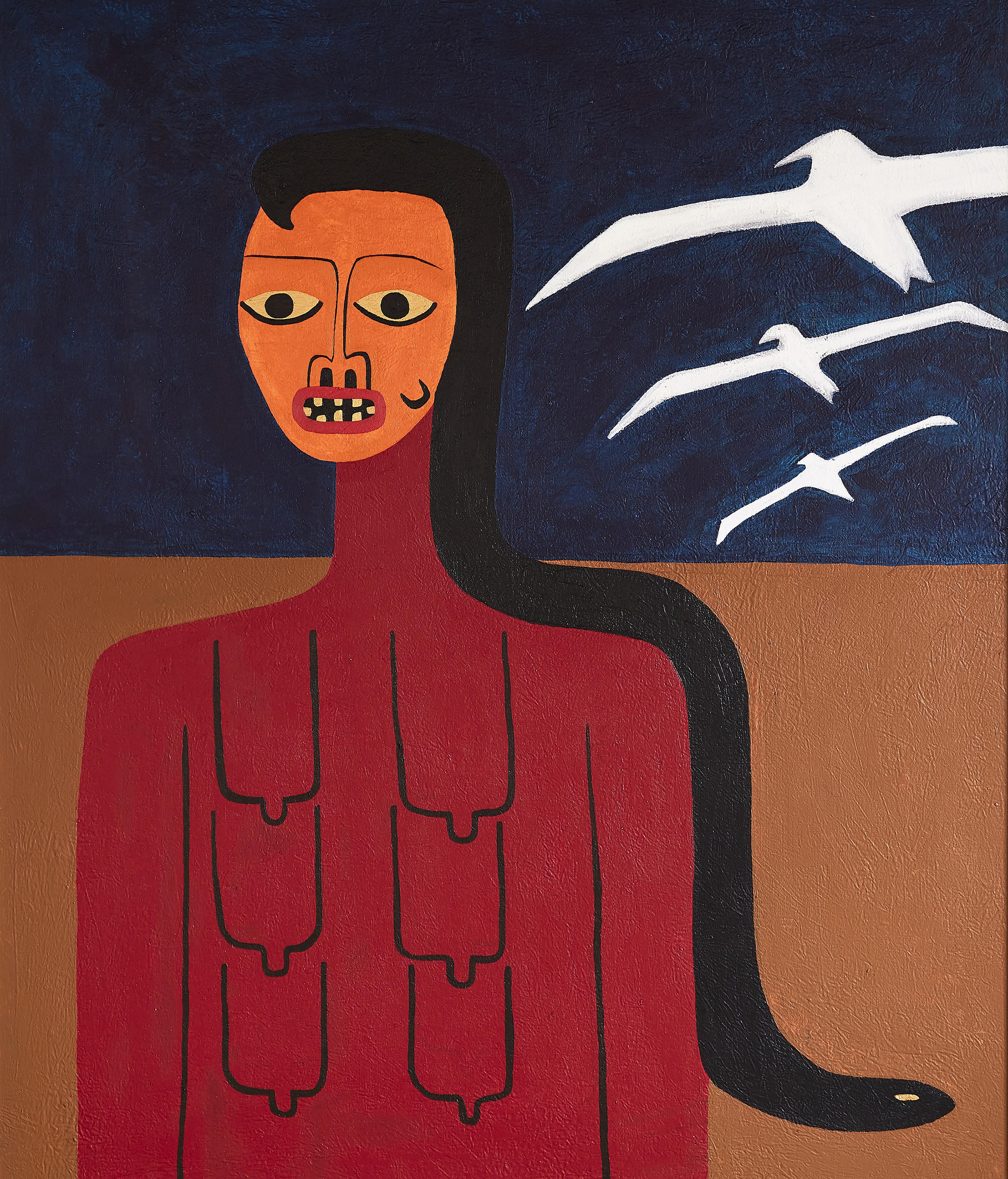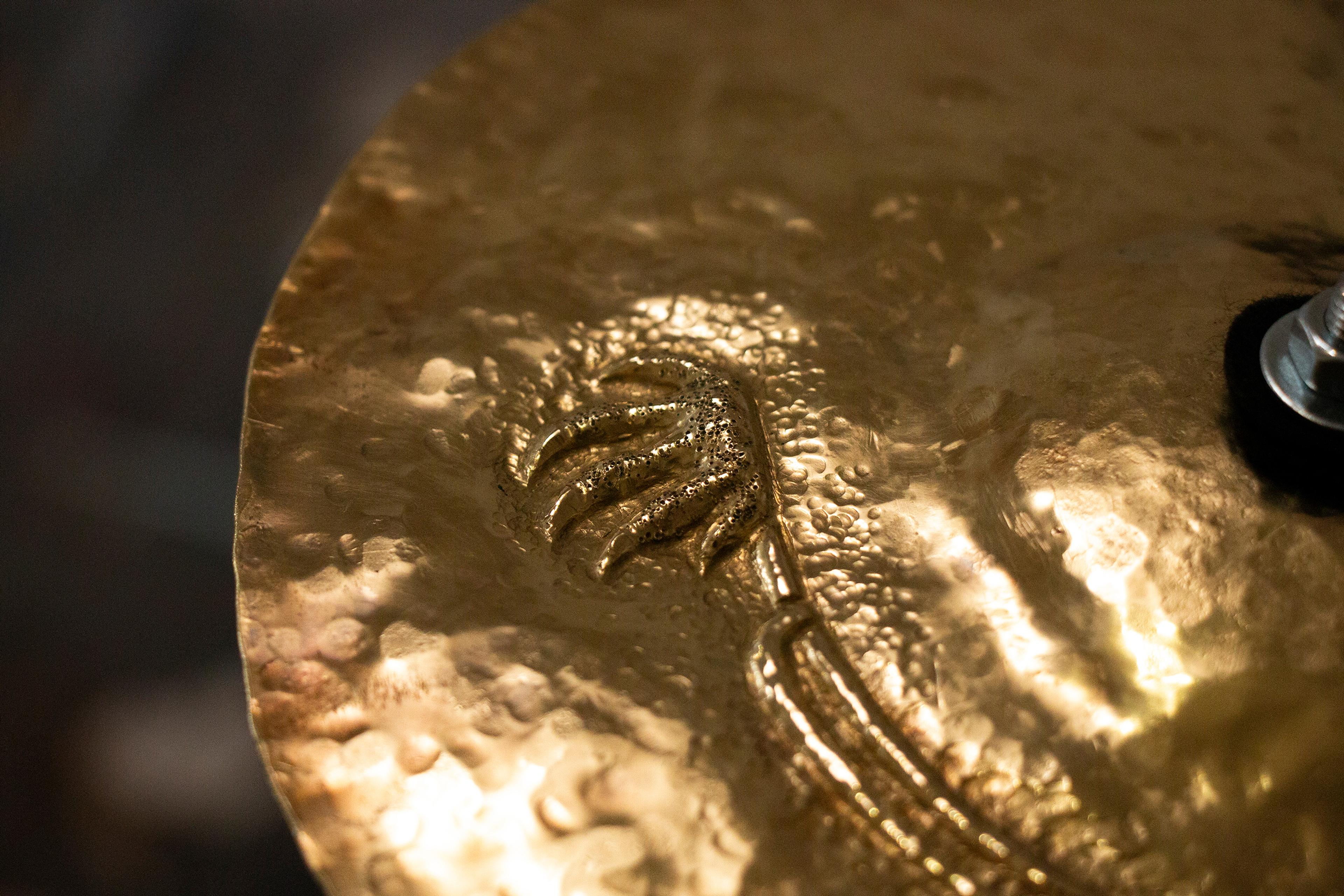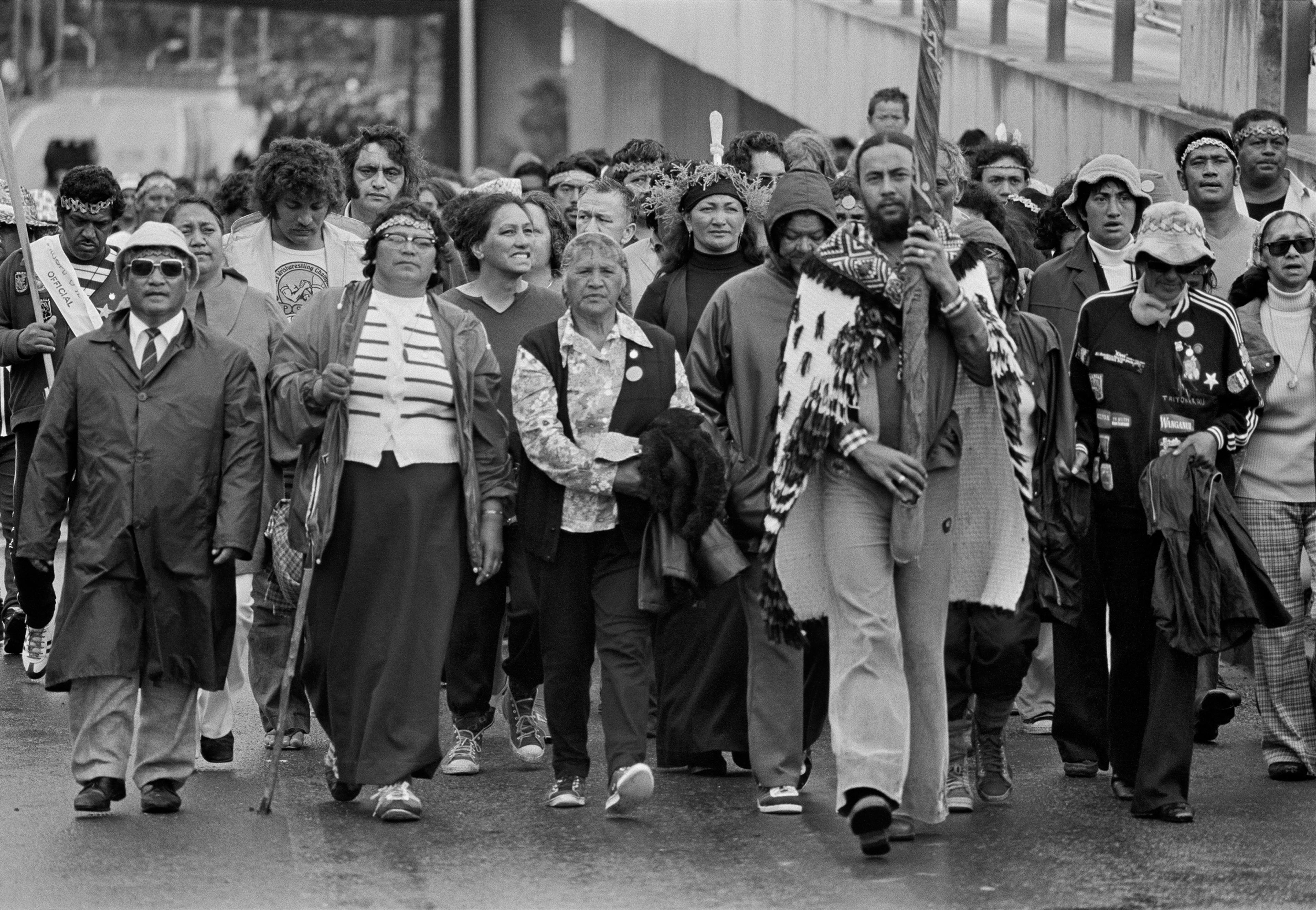Whai Wāhi
Melanie Tangaere Baldwin
Madison Kelly
Kura Te Waru Rewiri
Robyn Kahukiwa
Diane Prince
Emily Karaka
Te Waka Hourua
John Miller
Ngataiharuru Taepa
Sky Hopinka
Inas Halabi
Co-curated by Abby Cunnane and Brooke Pou
21 November 2025 – 29 March 2026
Whai Wāhi emerges as a contribution to contemporary discourse around Te Tiriti o Waitangi – which remains a primary reference for artists, among others, in the negotiation of identity and relationships here in Aotearoa – and ideas extending from this. In this full-gallery, intergenerational exhibition, artworks from the 1970s to the present articulate expressions of mana motuhake, dissent, and an enduring will to engage in critical dialogue about our shared colonial past.
Anchoring the exhibition is the Treaty panel from Te Papa, redacted by artists and activists Te Waka Hourua on 11 December 2023. Brought into the gallery, the panel continues its work of calling for accurate representation of Te Tiriti o Waitangi. The panel is situated within the company of artworks that uphold related propositions, explicitly or more subtly signalling the need for change, and those affirming the continuity of connection to whenua and tūpuna.
Significant works by eminent Māori artists including Kura Te Waru Rewiri, Robyn Kahukiwa, Diane Prince, Emily Karaka and Ngataiharuru Taepa sit alongside a series of photographs by John Miller documenting watershed historical protests in Aotearoa. The exhibition includes selected works from Ngā Puhipuhi o Te Herenga Waka—Victoria University of Wellington Art Collection and others loaned for the occasion. In different ways, each artwork voices the need for remembrance and resistance.
Whai Wāhi also features new work by contemporary artists Madison Kelly and Melanie Tangaere Baldwin. Tangaere Baldwin’s Matakite (2023) asserts clear-sighted tūpuna knowledge and tino rangatiratanga that exists before and beyond the present moment, while Hine Whakawetewete (2025) embodies the potential for collective emancipation. Madison Kelly’s sound installation, Heed a tohu, cradle a branch (2025) (an extension of their work made for Whāia te Taniwha at Christchurch Art Gallery Te Puna o Waiwhetū), evokes the whakapapa of taniwha in relation to bodies of land and water, and timescales that go beyond the human. Extending beyond Aotearoa, the exhibition includes moving image works by Sky Hopinka (Ho-Chunk Nation / Pechanga Band of Luiseño Indians) and Inas Halabi (Palestine), narratives of opposition to the displacement of Indigenous people in their own lands.
Whai Wāhi opens 50 years after the 1975 Land March, since the establishment of the Waitangi Tribunal, and at a time when both the Tribunal and Te Tiriti are under what legal academic Dr Carwyn Jones has recently described as “sustained attack”, while the exhibition's title, Whai Wāhi, cites the seeking of space that underscores the efforts of movements pursuing the return of land and the right to be heard.
With thanks to Barbara Blake and the Ronald Woolf Memorial Trust for their generous support of this exhibition.
Te Pātaka Toi Adam Art Gallery summer closedown: 20.12.25 – 19.01.26
Melanie Tangaere Baldwin (Ngāti Porou, Rongomaiwahine) is a māmā, an artist, curator, and arts educator. She is former director/founding member of HOEA! Gallery in Tūranga Nui a Kiwa, Gisborne. Her work is largely focused on mana wāhine, Indigenous and marginalised peoples, and the effects of capitalism, imperialism and settler colonialism. Recent exhibitions include Flaming Star, Dowse Art Museum; He Hokinga Mahara, Blue Oyster Art Project Space and I Carry Your Love on My Back, Soft Shell, Te Tuhi (all 2025). In 2024 she was the recipient of the 2024 Yorkshire Sculpture Park and Te Tuhi New Zealand–UK Residency Award.
Madison Kelly (Kāi Tahu, Kāti Māmoe, Pākehā) is an Ōtepoti based artist, musician, and kaiārahi/lead guide at Te Korowai o Mihiwaka, Orokonui Ecosanctuary. Led by Kāitahutaka, percussion, and field research, their practice examines sensory means for recording and relaying whakapapa. Recent exhibitions include Whāia te Taniwha, Christchurch Art Gallery Te Puna o Waiwhetū (2025), Kōrero Huna with Luke Shaw (for Time of Waiting across Christchurch Art Gallery Te Puna o Waiwhetū and Te Wai Ngutu Kākā, 2025); Paemanu: Awa Toi, Asia Pacific Triennial, QAGOMA (2024) and Springtime is Heart-break: Contemporary Art in Aotearoa, Christchurch Art Gallery Te Puna o Waiwhetū (2023).
Ngataiharuru Taepa (Te Arawa, TeĀti Awa) lives in Te Papaioea Palmerston North where he is Kaihautu Toi Māori – Director of Māori Arts at Toi Rauwhārangi College of Creative Arts. Taepa’s practice has a sustained focused upon kōwhaiwhai, interpreted through technologies including digital routers, acrylic laminates, and digitally carved treated plywood. In 2015 his solo exhibition Te Tini a Pito: 12 years of kōwhaiwhai was presented at Pātaka Art + Museum. He was part of the group that created Te Rau Karamu, the marae for Massey's Pukeahu campus, which opened in in 2021. Taepa’s work is represented in collections including Te Papa Tongarewa Museum of New Zealand, Christchurch Art Gallery Te Puna o Waiwhetū, Auckland Art Gallery Toi o Tāmaki and TāmakiPaenga Hira Auckland War Memorial Museum.
Robyn Kahukiwa (Ngāti Porou, Te Aitanga-a-Hauiti, Ngāti Hau, Ngāti Konohi, Te Whānau-a-Ruataupare) was an artist, and beloved children’s book author and illustrator. Since the 1970s her painting has explored issues including colonisation and dispossession, motherhood and wellbeing, whakapapa and tikanga Māori. Kahukiwa gained wide recognition through the 1983 exhibition Wāhine Toa and exhibited with Haeata Māori Women’s Art Collective in their exhibitions Karanga Karanga (1986) and Mana Tiriti (1990) at City Gallery Wellington. From the mid-1980s, her work has been included in most major exhibitions of Māori art. In 2020, Kahukiwa received Te Tohu Aroha mō Te Arikinui Dame Te Atairangikaahu at Te Waka Toi Awards. In 2023 her work was part of Sharjah Biennial 15: Thinking Historically in the Present, and a significant survey exhibition, Tohunga Mahi Toi, curated by Roma Pōtiki, is currently touring Aotearoa.
Kura Te Waru Rewiri (Ngāpuhi, Ngāti Kahu, Ngāti Rangi, Ngāti Kauwhata) is an artist, academic and educator. She was born in Kaeo, Whangaroa, and encouraged to study art by teacher and early mentor Buck Nin. She was a founding member of the 1970s protest group Ngā Tamatoa, and began painting seriously in 1985. Across a diverse range of forms, her practice has focused on subjects including Te Tiriti o Waitangi, te Hāhi Rātana and the language of kōwhaiwhai. Her work has been included in significant exhibitions including Māori Art Today, touring alongside Te Māori –Te Hokinga Mai (1986-67) and Te Waka Toi: Contemporary Māori Art which toured the US and Aotearoa (1992-1994). In 2019 Te Waru Rewiri was recognised with a Te Waka Toi award, 'Te Tohu o Te Papa Tongarewa Rongomaraeroa | Outstanding contribution to Ngā Toi Māori.
Diane Prince (Ngāpuhi, Ngāti Whatua, Ngāti Kahu) is an artist whose practice spans painting, weaving, installation and set design and consistently emphasises Māori rights, particularly those of women. A longtime activist, Prince was a researcher for the Takaparawhau / Bastion Point occupation between 1977 and 1978. Major exhibitions include her solo show Veiled Legacy at City Gallery Wellington (2001); her work was part of Māori Art Today, touring alongside Te Māori –Te Hokinga Mai (1986-87), Korurangi: New Māori Art at Toi o Tāmaki Auckland Art Gallery (1995), and most recently a touring survey of works curated by Gina Matchitt, Diane Prince: Activist Artist (2024–2026). Her work is held in collections throughout Aotearoa, including Te Papa Tongarewa Museum of New Zealand and Ngā Puhipuhi o Te Herenga Waka—Victoria University of Wellington Art Collection.
Emily Karaka (Ngai Tai ki Tāmaki, Te Kawerau ā Maki, Ngāti Tamaoho, Te Ākitai Waiohua, Te Awhiwaru, Ngāti Mahuta, Ngāti Tāhinga, Ngāti Kahu and Ngāti Hine) has described her paintings as ‘political landscapes’. These works advocate passionately for tino rangatiratanga (Māori sovereignty), social and environmental justice, and are recognisable for their vibrant colour, abstract expressionist gesture, and powerful use of text. Selected exhibitions include Five Māori Painters, Auckland Art GalleryToi o Tāmaki (2014) and Two Artists: Emily Karaka & Shona Rapira Davies, Te Papa Tongarewa Museum of New Zealand (2015); more recently Karaka has produced new paintings for the 22nd Biennale of Sydney, NIRIN (2020), and Toi Tū Toi Ora: Contemporary Māori Art (2020–21). In 2024 Emily Karaka: Ka Awatea, A New Dawn, a major survey of her work, curated by Megan Tamati-Quennell and Hoor Al Qasimi, was presented at Sharjah Art Foundation.
Te Waka Hourua is a tangata whenua led group of activists and artists. They formed in Paekākāriki in 2019, as an offshoot of the Aotearoa branch of Extinction Rebellion. The rōpū are known for their ongoing engagement with Te Papa Tongarewa, resulting in their action on December 11 2023, when they redacted a display panel in the Te Tiriti o Waitangi: Ngā tohu kotahitanga Treaty of Waitangi: Signs of a Nation exhibition. Te Waka Hourua went on to host an exhibition called Whītiki, Mātike, Whakatika! at Enjoy Contemporary Art Space in 2024, and to publish a book with the same name with 5ever Books. While they are primarily concerned with Te Tiriti, social and climate justice, Te Waka Hourua encourages everyone to gain an understanding of our collective past, current and future conditions – including Te Tiriti – and what role we want to play in solving the collective challenges we face in society.
John Miller (Ngaitewake-ki-te-tuawhenua, Uritaniwha and Ngāti Rehia hapū of Ngāpuhi) is a documentary photographer who has worked since the late 1960s, amassing an archive of images of radical protest in Aotearoa. These are shot from the perspective of someone politically involved and invested, and include images from of our most significant historical resistance movements, among them the 1975 Land March, the 1981 Springbok Tour and the 2004 Foreshore and Seabed Act protests. Most recently he has photographed the Toitū te Tiriti hīkoi in late 2024 and numerous solidarity rallies for Palestine. Selected recent exhibitions include Pouwātū: Active Presence, a collaboration with Elisapeta Heta, NIRIN: 2020 Biennale of Sydney and subsequently at Objectspace, Tāmaki Makaurau and Things that shape us, curated by Melanie Oliver at Christchurch Art Gallery Te Puna o Waiwhetū (2021).
Sky Hopinka (Ho-Chunk Nation / Pechanga Band of Luiseño Indians) is a filmmaker dedicated to developing forms of cinema that centre the perspectives of Indigenous people. Significant to his work is the study and teaching chinuk wawa, a near extinct language indigenous to the Lower Columbia River Basin. His work was a part of the 2017 Whitney Biennial, the 14th Gwangju Biennial in South Korea and the Göteborg International Biennial in Switzerland in 2023. He was a guest curator at the 2019 Whitney Biennial and has had solo exhibitions at the Center for Curatorial Studies–Bard College (2020), LUMA in Arles, France (2022), and Frye Art Museum in Washington, USand Kunsthalle Friart in Switzerland (2024).
Inas Halabi (Palestine) is an artist and a filmmaker living in the Netherlands. Her practice is concerned with how social and political forms of power are manifested in the land and soundscape and the impact that suppressed histories have on contemporary life. Recent exhibitions and screenings include the 36th Galway Film Fleadh (2024); the Brookline Arts Center (solo, 2024); Luleå Biennial (2024); Hot Docs Canadian International Documentary Festival (2023); de Appel Amsterdam (solo, 2023); Showroom London (solo, 2022); Europalia Festival, Brussels (2021) and Silent Green Betonhalle, Berlin (2021). In 2024 her work was shown in The Centre Does Not Hold, curated by Jess Clifford, at Enjoy Contemporary Art Space in Te Whanganui-a-Tara.

Melanie Tangaere Baldwin, Matakite, 2023, acrylic on board, 1070 x 920mm. Image courtesy of the artist.

Madison Kelly, Heed a tohu, cradle a branch (detail), 2025, brass, steel, felt, mallets, drumsticks, harakeke, cord, dimensions variable. Image courtesy of the artist.

John Miller, Land March, Aotea Quay, 1975, archival pigment print from 35mm negative, printed by Chris Corson-Scott, 2025, 445 x 580mm framed. Image courtesy of the artist.